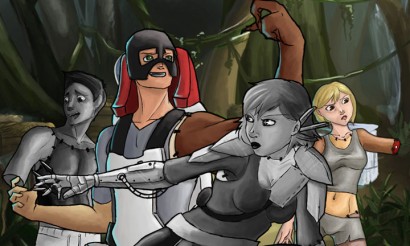A Study into current Design Structures of Modern-day Massively Multiplayer Online Role-Playing Games

This report aims to give a critical view of a genre of games known as Massively Multi-player Online Role-Playing Games (MMORPGs). It investigates reasons for play, what makes a game of this genre popular and current innovations in the field. The report also examines the traditional methods of Role-Playing for fantasy games, and attempts to analyse whether or not the genre has successfully made the transition to computers whilst retaining the full experience of role-playing. In addition there is an appendix detailing my experiments in the field of games design based on the research previously described.
Real-Time Deformation for Computer Games

This paper looks at the various methods available for the implementation of real-time deformation for use in computer game environments. We will analyse a number of published methods and we will examine how these methods can be used to produce real-time deformation in future game developments.
The making of Randomware
The idea began on a bus journey. I was playing a game called Warioware (Nintendo, 2003) on the Gameboy Advance. I’d already played each of the two hundred so-called microgames and completed the other modes. All that was left was to play the same microgames over again, competing against my own score. Since microgames are as simple as they are, I also had plenty of time to think about what I was doing. I realised that after exploring and unlocking every part of the game by now, it was no longer as fun as when I had first played it. The reason was because there were no surprises left to find which, when unlocked, each feels like a little reward for playing a new piece of game; the reward being a new challenge set and being new somehow recreates the exciting feeling of playing a game for the first time. (Well, you are playing that piece of game for the first time.) If only there was something left to unlock, although I would still be playing the same game, the possibility of a new discovery would give me more incentive, making the same experience more fun. If only there was more to unlock, if only it never ran out of freshness, then it would never run out of fun. It seemed a totally impossible idea, but it was so crazy that I thought it just might work. I was certain that, even if someone else had already thought of it before, in the modern state of the computer games industry, it’s an idea that sounds far too risky to even attempt, it’s an idea without proven success. Even so, it was an idea I became interested in trying out for myself, it contained the same excitement as playing Warioware did when I was trying to unlock a new level: the reward for taking the risk is the possibility of unlocking a brand new discovery.
Why do We Play Video Games and What In Terms of Design Influences our Choices

The aim of this project is to research onto the reasons why we play video
Investigative Study into the Innovation of Pre-Rendered Adventure Games

This report is an investigative study into methodologies to enhance the gaming experience. I will also be looking at the longevity of 3D pre-rendered games in comparison to the relative flexibility of 3D run-time games. In particular I want to focus on pre-rendered games of the ‘interactive movie adventure’ genera type. These games focus on the story line narrative thus creating a richly detailed immersive environment.
Real-Time Character Animation for Computer Games

The importance of real-time character animation in computer games has increased considerably over the past decade. Due to advances in computer hardware and the achievement of great increases in computational speed, the demand for more realism in computer games is continuously growing.
Research and Development into an Innovative Computer Game Designed to Relieve Stress

Group Project with Thomas Stratford
